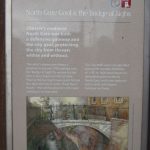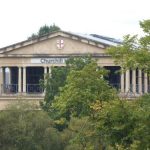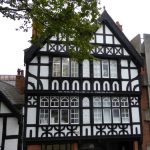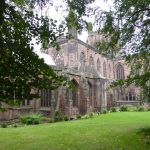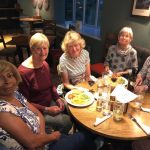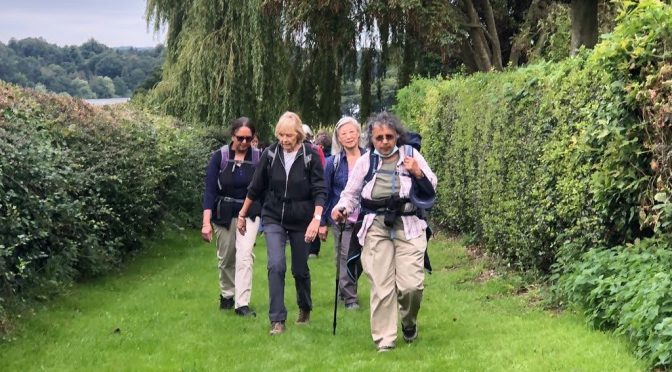By some lovely twist of fate, I spent seven weeks of the first lockdown in 2020 marooned in youth hostel at Loch Ossian in Corrour, where my friend is the manager. During my sojourn I grew to appreciate what a special place it was wanted to share it with my fellow Polyramblers, hence the idea for this trip was born. The facilities in the Loch Ossian hostel are rudimentary and not to everyone’s taste, so it was decided to base the weekend in Fort William, with access to a variety of hiking and sightseeing options, not least Ben Nevis and to culminate with a day in Corrour.
My thanks to all contributors to this report and especially Sandy and Danny for leading the strollers and helping with the overall planning.
Twenty four Poly Ramblers met at Glasgow Central station on Friday 30th September to travel up to Fort William. About half of them had arrived the day before, without event, and spent a morning exploring Glasgow. The remainder valiantly weathered the last minute scheduling changes – complete with buggy transfer to the train to secure seats en-masse – and delights of en-route delays to finally arrive 90 minutes late. Fortunately there was a private coach booked for the remainder of the journey and the driver was not only patient and helpful, he provided an interesting and entertaining commentary along the route. The group finally arrived in Fort William at 7.00pm. The group was joined by two other members the next day who had travelled independently. Continue reading AUTUMN WEEKEND IN FORT WILLIAM – SEPT/OCT 2022
Category Archives: Trip reports
CHESTER TRIP – TUESDAY. CITY WALLS WALK
We gathered at the Northgate to walk the almost 2 mile circuit, the most complete town walls in Britain. After the Civil War they were no longer required to be fortified for defence and were developed as a recreational walkway. We walked anti-clockwise and the first section gave us a good view of the racecourse. This is the oldest one in the country, dating back to 1539. It is on the site of the port of Chester which was bustling in Roman times but the River Dee had silted up here by the 1500s and changed its course. We were able to observe many of the various buildings we had seen on Friday from a different perspective. The view of the cathedral was particularly impressive and the famous Eastgate clock celebrating Queen Victoria’s Diamond Jubilee proved popular for photos. One section of the walls near Eastgate collapsed in 2008 and repairs are ongoing. Various panels showed us the timeline of the repairs and how these have been carried out. On our return to Northgate we dispersed, some to collect their luggage and make their way to the station to return to London, others to spend a little more time in this fascinating city steeped in history before heading home.
Susan. Photos by Stuart
CHESTER TRIP – MONDAY NIGHT MEAL
Ida’s photos from our last night group meal at Little Owl.
CHESTER: MONDAY STROLLER AND HIKERS WALKS
Strollers walk led by Judy – Chester outskirts
On Monday 30th August, the strollers set out to follow one of the walks in Danny’s book. The walk started at the stone cross in the centre of Chester, which marked the centre of the Roman fortress. We then proceeded down Bridge St and Lower Bridge St till we came to the river Dee. Turning right we walked along beside it and on to a part of the city walls. We came to Grosvenor Road and crossed the river on the Grosvenor Bridge. It was, on construction, the longest single span stone arch bridge in the world, a title it kept for 30 years. It was opened in 1832 by Princess Victoria of Saxe Coburg Saalfeld and her daughter, the future Queen Victoria. Named after the Duke of Westminster, who owned property and land nearby. Following Eaton Road we entered the Duke’s Drive through some very impressive gates. There followed a very straight walk through woodland for a few kilometres. It was not particularly exciting, but quite pleasant . We eventually found our way back to the River Dee and turned back towards the city. At that point we stopped for a short break, where those of us who had brought sandwiches could eat them. Although the map in the book showed us a route following the river all the way round , we decided to cut across the Meadows. We re-entered the city across the Queen’s Park suspension bridge, where I released my charges, and hoped they had enjoyed their walk.
Judy Continue reading CHESTER: MONDAY STROLLER AND HIKERS WALKS
CHESTER – SUNDAY HIKERS WALK – MOSTYN TO PRESTATYN
Twenty five participants took the 9.51 train to Flint in Wales. Here one Poly, unaware that we had arrived at the destination, was still in the toilet. The conductor very kindly kept the train waiting while we managed to call her and she got off just in time! We were met by two minibuses to take us to the start of our walk just before Mostyn. We were to follow the Wales Coast Path to Prestatyn. We climbed up through woods and after crossing a few fields descended through a pretty woodland gorge to Ffynnongroyw. We struggled with the pronunciation of the latter but were helped by a friendly local. At the bottom of the gorge we stopped outside the picturesque stone Garth Mill buildings. Several members played with two very friendly little dogs, one of which relieved itself on the leader’s rucksack while a group photo was being taken! Ffynnongroyw was built in the 1800s to house local miners and we could see numerous former chapels , a large parish church and terraced miners’ cottages. Continue reading CHESTER – SUNDAY HIKERS WALK – MOSTYN TO PRESTATYN






